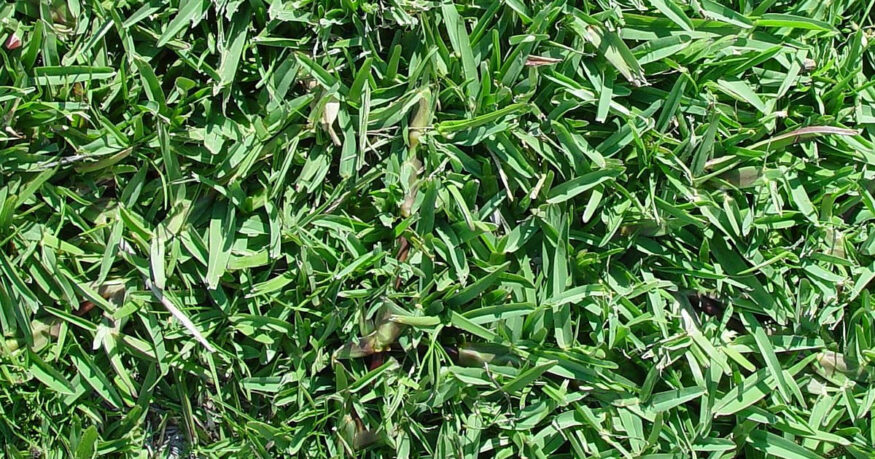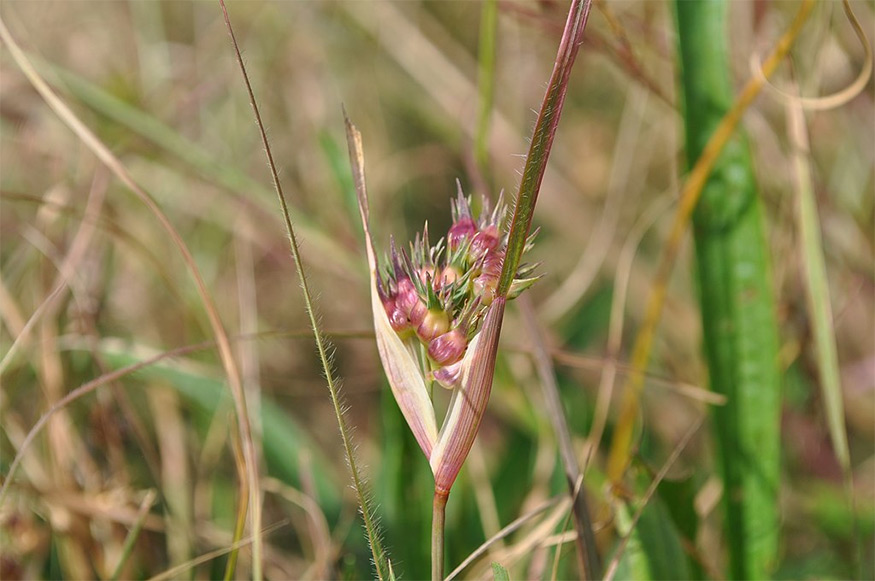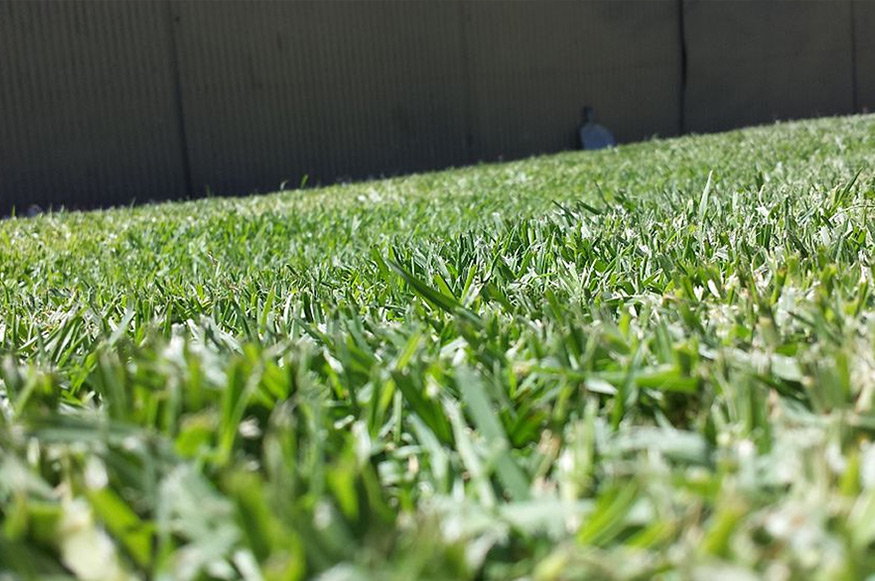Buffalo grass is one of the few species used as a turfgrass in America that actually originated in this country. Because of that, it is better adapted to climates within the states than other options. But it also takes a fair amount of care to establish and is prone to weed overgrowth.
In this guide, we’ll look at important buffalograss characteristics to determine if it’s right for your yard. We’ll also tell you everything you need to know to care for this warm-season grass using our helpful lawn care calendar.

Buffalo Grass Overview
| Also Known As | Buffalograss; Buchloe dactyloides |
| Type of Grass | Warm season perennial |
| Optimal Zones | Northern, transition, and southern zones |
| Root Structure | Very deep |
| Winter hardiness | Great |
| Heat tolerance | Great |
| Shade tolerance | Poor |
| Water Requirements | Low |
| Drought Tolerance | Excellent |
| Self Repair Capacity | Moderate to high |
| Overall Maintenance Requirements | Low after establishment |
The History of Buffalo Grass
Fossil evidence tells us that buffalo grass has been growing in the United States for at least 7 million years. It is native to The Great Plains and grows naturally from Canada down to Mexico. It was a favorite of the American bison, as its name suggests.
During early westward expansion in America, this grass was used exclusively as a forage grass for livestock. It wasn’t until the 1930s that it began being used as a turfgrass. But the expense and work needed to plant and establish buffalograss made it a less appealing option to homeowners.
Today, there are a variety of buffalo grass cultivators, many of which are more affordable and less difficult to get started. In fact, there is now a suitable buffalograss variety for just about every region in the US.
Buffalograss Characteristics

Buffalo grass is one of the lowest-maintenance grasses available. It doesn’t need much mowing, can survive on a quarter of the water required for Kentucky blue grass, and uses very little fertilizer. But it also has some limitations that need to be considered before installation.
To help you decide if buffalograss is right for your yard, let’s take a closer look at the characteristics of this species.
Type of Grass
Buffalograss is a perennial warm-season grass. “Perennial” meaning it comes back every year. And “warm season” meaning it does most of its growing when temperatures are hot.
In most climates, it will turn brown and go dormant in the winter. In dry climates, it will also go dormant in the summer if not properly irrigated.
Optimal Zones
In the US, the Legacy buffalograss cultivator is used primarily in northern and northern transition zones. Prestige is used in the south and up into transition zones. A third common cultivator, UC Verde is popular along the coast in California and down into Arizona.
Root Structure
Buffalo grass has an impressively deep root structure, reaching depths below 6 feet. It grows and spreads via above-ground stolons that put down roots wherever they touch the soil. It can spread quickly and shows steady growth habits during the warmer months.
Winter Hardiness
Buffalo grass, especially varieties adapted to northern climates, is winter hardy. It will begin going dormant when nighttime temperatures dip below 50 degrees. It is an especially good choice for areas that experience dry, cold winters.
Heat Tolerance
In general, buffalo grass has a good heat tolerance. It grows best at temperatures between 75 and 95 degrees. Varieties adapted to southern climates tend to fare better in extreme heat.
Shade Tolerance
Buffalo grass is not overly shade tolerant. It grows best in full sun but can handle partial shade so long as it still gets at least 6 hours of sunlight a day.
Water Requirements & Drought Tolerance
Buffalo grass requires 50 to 75% less water than most warm-season grasses. It grows best with infrequent, deep waterings—about 1 inch every two weeks. But it will stay green and continue to grow with as little as 1 inch of water every four weeks.
This grass species does not require irrigation under most circumstances and is very drought-tolerant. It will go dormant in dry summer conditions but easily bounces back in the fall.
Self Repair Capacity
Buffalograss has a moderate traffic tolerance. It can handle heavy traffic for short periods without injury. It also does well with moderate traffic for extended periods. Where it suffers is continuous heavy use for days on end.
It does have a decent ability to self-repair, especially after times of drought dormancy.
Buffalo Grass Lawn Care Calendar

It doesn’t take much maintenance to keep buffalo grass thriving once it is established.
New lawns can be installed via sod, plugs, or seed. The former is more expensive, but the latter requires a lot of work and patience.
All versions of new buffalo grass require a lot of water and careful care. Spring is the best time to start new buffalo grass.
But once this grass is established, most of your work is done. At this point, you can begin following our handy buffalograss lawn maintenance plan, below.
Spring Care
Buffalo grass will begin to green up and start growing once temperatures reach about 55 degrees in spring. At this point, most maintenance centers around fighting weeds and preparing the grass for summer.
Mowing
Buffalo grass can be maintained at any height between 2 and 4 inches. For a cleaner-looking lawn, set your mower lower and mow about once weekly through the spring once the grass fully greens up. For a low-maintenance lawn, set your mower higher and mow once or twice per month.
In dry climates, many homeowners choose to not mow aside from one “cleanup” mowing at the beginning of the spring.
Fertilization
Buffalo grass does not require much nitrogen to grow well. In fact, using too much fertilizer is likely to add to your weed problems rather than help your grass thrive.
In late spring, apply 1 pound of nitrogen per 1,000 square feet.
This is also the best time of year to have a soil test done.
Weed Control
Using a pre-emergent weed control spray in early spring can help better control weed problems that plague this type of grass. However, not all products are safe for use on buffalo grass, so always check the label.
Post-emergent products are even more likely to harm buffalo grass. These products are best used while buffalo grass is still dormant in the early spring. Once the grass greens up, they are likely to cause discoloration.
At this point, hand-pulling weeds is the best option.
Watering
Irrigation is generally not needed in spring for buffalo grass that is well-established.
Pest and Disease Control
Pest and disease problems will vary by region, but in general, buffalo grass is very resistant to pest damage. Chinch bugs tend to cause the most damage in unhealthy grass. If you see signs of these pests, use an approved insecticide to treat the infestation.
Diseases rarely impact buffalo grass and generally do not cause problems this time of year.
Aeration and Dethatching
Spring is the best time to have your lawn aerated to avoid compact soil. Aerated soil is better able to accept nutrients and water. This is generally needed yearly for lawns that experience moderate to high traffic.
Mature buffalo grass lawns are prone to thatch buildup and generally require dethatching every spring. This can be done with a dethatching machine or rake.
Overseeding
Young lawns may benefit from overseeding in the spring or fall to help fill in thin spots. You can use the same type of buffalo grass or another buffalo variant recommended for your region.
Set seed later in the spring when temperatures have warmed up but before precipitation has decreased. You may need to supplement irrigation to assure grass stays moist until newly germinated sprouts are well anchored.
Summer Care
Buffalo grass will grow the most during the summer if it gets enough water and plenty of sunshine.
Mowing
Continue mowing as you did in the spring. Buffalo grass does not grow vertically very fast, but in wet summers you may have to increase your mowing frequency. Mow often enough to ensure you’re taking no more than ⅓ of the blade height each time.
Fertilization
Fertilize with a nitrogen fertilizer at a rate of 1 pound per 1,000 square feet in late July. If the soil test you did in spring reveals any substantial deficiencies, apply a fertilizer that includes the missing nutrients.
Watering
Buffalo grass will go dormant in the summer if it does not receive enough water. Many homeowners choose it for its low water needs and prefer to let this happen.
If you would rather keep your buffalo grass green, apply 1 inch of water in a single session every two to four weeks. For clay soil, you may have to allow time for the water to soak in between sessions. Even still, it is best to try and apply the full amount over the course of one morning.
Weed Control
Continue carefully applying buffalo grass safe spot treatments as needed throughout the summer. Pulling weeds can be safer but will take significant time.
Excessive weed growth is usually a sign of overwatering or overfertilization. By further restricting irrigation you can typically reduce weed growth in the summer.
Pest and Disease Control
Continue monitoring for insect damage throughout the summer. Treat with targeted insecticides only when needed.
Fall/Autumn Care
The fall season is all about preparing your buffalo grass for winter dormancy.
Mowing
Continue mowing as you did throughout the summer. For low and “no-mow” lawns, you likely won’t have to mow at all this time of year. Stop mowing once growth stops.
Fertilization
Buffalo grass does not typically require fertilizer in the fall. However, if your area experiences a particularly rough winter, you may want to apply a winterizer fertilizer in early November. This can help your grass survive the cold months and come back greener the next year.
Weed Control
Continue with careful spot control and manual weed-pulling as you did through the summer.
Watering
Irrigation is generally not needed in the fall. However, if there is not much rainfall, you may need to supplement as you did through the summer.
Overseeding
Young lawns may benefit from overseeding in the fall or spring to help fill in thin spots. You can use the same type of buffalo grass or another buffalo variant recommended for your region.
Set seed early in the fall when temperatures are still warm but precipitation has increased. You may need to supplement irrigation to assure grass stays moist until newly germinated sprouts are well anchored.
Winter Care
Buffalo grass will start to go dormant as soon as temperatures drop below 50 degrees overnight. After the first freeze, it will be completely dormant.
This species typically will not require any care during the winter. It can survive weeks without any precipitation, so winter watering is not necessary. Buffalo grass will come back in the spring once temperatures begin to rise.
Sources:
Missouri Department of Conservation